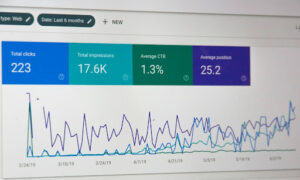In digital marketing, you have a multitude of data and metrics to look at – which allow you to measure and optimize your marketing efforts based on evidence instead of assumptions. However, not all metrics are equally important. There are an infinite number of ways to slice and dice the data from your campaign to gather insights about what’s working and what isn’t. Knowing which data is most valuable, and what metrics you should be looking at is often the first step in creating effective digital marketing campaigns that get real results.
Business Goals Vs. KPI: What’s The Difference?
To better understand which metrics are most important – let’s take a closer look at the difference between business goals and key performance indicators (KPIs). A business goal is the overarching outcome you hope to achieve – such as increasing sales or growing your customer base.
A business goal should always have a tangible target associated to it. For example, increase sales by 10% over the next quarter or have ‘x’ number of new customers join your email list every month.
With your business goals in mind, you can now determine your KPIs.
Simply put, KPI is the measure of your business goal. In the example above, where the business goal is to increase sales by 10% – you might want to define multiple KPIs to get the full picture on how well you are progressing towards achieving your business goal. For instance, the KPIs can be ‘Conversion Rate’, ‘Average Order Value’ and ‘Cart Abandonment’ if you are an eCommerce business.
The KPIs will then identify which metrics and what data you need to collect to monitor the progression of your business goals. For example, for the ‘Conversion Rate’ KPI, you may want to use different metrics such as mobile vs. desktop conversion rate, conversion rate per landing page or conversion rate per channel. You wouldn’t want to use a metric such as social media followers or newsletter unsubscribe rate because those are not tied to the KPI that you are trying to measure.
In essence, a KPI can be made up of multiple metrics – but not all metrics are KPIs.
Now, let’s take a look at the 5 key metrics in digital marketing that you should be using to assess the success of your marketing campaigns.
Customer Lifetime Value
Customer Lifetime Value (CLV) is a metric showing how much the typical customer will bring into your business in terms of revenue for as long as they are a customer. In essence, this metric measures customer loyalty.
Formula: [Average Value of a Sale] x [Number of Repeat Sales] x [Average Retention Time]
For example, if a customer spends $20 per month on your business for two years, then CLV would look like this:
$50 x 12 (months) x 2 (years) = $1200 in total revenue or $600 per year.
Customer Acquisition Cost (CAC)
Customer Acquisition Cost (CAC) measures how much your business must spend to acquire a new customer. Also, it tells you how much you need to earn from each customer to run a viable company.
In essence, CAC is critical to make sure that you are not spending more in marketing than you are making out of that investment.
Formula: [Total Marketing Spend] / [Number of New Customers]
For example, if you spent $500 on an Email marketing campaign and $500 PPC ads campaign which acquired 500 new customers your CAC will look like:
$1000 / 500 = $2
Conversion Rate
The conversion rate is the percentage of prospects/customers which visited your website/app and completed a desired goal (conversion) for your business. For example, submitting a form to sign up to your services or purchasing your product.
Formula: [Number of conversions] / [Number of visitors] x 100
For example, if your business generated 30 purchases from 1000 visitors that came to your product detail page (PDP) then your conversion rate would be:
50 / 1000 x 100% = 5%
Engagement Rate
The engagement rate tells you how actively involved with your website/app content your audience is so you can understand if your content resonates with your audience. High engagement means increased awareness which ultimately leads to increased revenue.
You can use engagement rate as a metric to understand which content performs the best so you can create more of it.
In Google Analytics (the most widely used web analytics), the formula to calculate engagement rate is
[Engaged Sessions] / [Total Sessions] x 100
For example, if you had 100 engaged sessions and 1000 total sessions then your engagement rate is:
100 / 100 x 100% = 10%
A session is considered an engaged session when a prospect/customer views a page for 10+ seconds, or views more than one page or triggers an action which is defined as a conversion (e.g., submit a form to sign up to your services)
Traffic Source
Seeing your traffic split by channel is much more insightful than simply an overall view. Channels are the source of traffic which led to a visit to your website/app. In essence, how did the prospect/customer land on your website/app. Channel examples below:
- Direct: Your prospect/customer simply typed in your URL on their browser or clicked on a saved bookmark. This traffic means that there is awareness and loyalty about your business.
- Organic Search: Traffic from non-paid search results clicks. This means that your content is performing well on the search engines.
- Paid Search: As opposed to Organic Search, this is traffic that came from clicking on paid search ads on the search results.
Final Thoughts
Your business goals and KPIs are only as good as your ability to achieve them. However, when it comes to digital marketing, you need to test different hypotheses and keep iterating until you have the optimal plan to grow your business. An up-to-date Digital Measurement Plan by choosing the correct metrics to measure and analyse will help you drive higher conversions and ultimately, increase your company’s revenue.
We hope that this guide has helped you in understanding the different metrics, how they work and the importance of choosing the right ones to grow your business. If you need help on choosing the right metrics and being confident on their accuracy, please contact Martech Ninjas to get the ball rolling.



































